• Dahabiya Nile Sailing •
Short Description: A Dahabiya Nile Cruise is the most unique, authentic and exclusive way to experience the Nile in elegance and comfort. Dahabiyas are traditional wooden sailing boats with private cabins with ensuite, originally designed to take 19th Century travelers along the Nile in comfort. For those who want to experience culture, history, and relaxation as they pass along the Nile Valley, there is no better way than a Dahabiya cruise.
Day 1
Cairo, check in to Dahabiya, lunch and sailing to Beni Suef. Dinner and overnight onboard.

Day 2
Sailing to Minya. Visit Meidum pyramid site and tombs. Continue sailing to Minya. Lunch, dinner and overnight onboard the dahabiya.
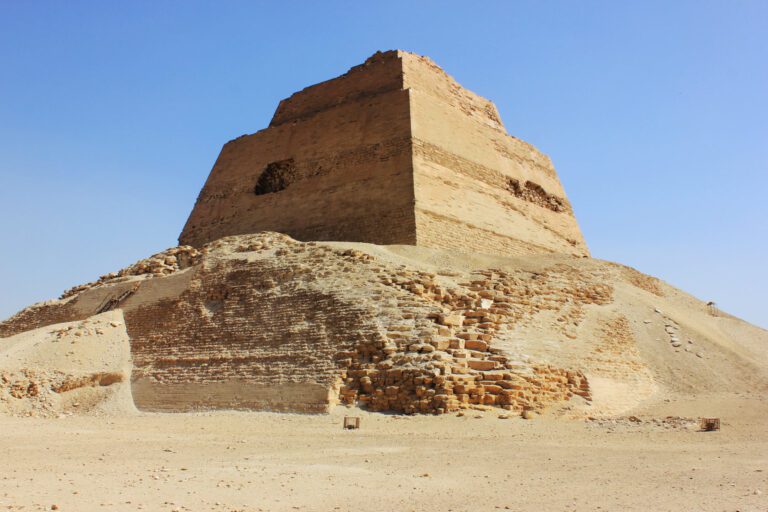
After breakfast, visit the Meidum pyramid site and tombs. About sixty-five meters (213 feet) high, this pyramid was originally designed as a seven step pyramid. Snefru became king around 2,575 BC. Snefru completed three pyramids, including this one. The pyramid was partially destroyed by human reuse of its materials. It is surrounded by a number of mastabas in which the sons of Snefru were buried.
Enjoy relaxing hours on the dahabiya, watching the river and life on the banks, and a leisurely lunch and dinner.
Day 3
After breakfast, visit Tel El Amarna, the capital city founded by Akhnaton. Explore the ancient city ruins, ruins of the palace and temples and the royal tomb. Visit El Ashmunein. Visit the necropolis of Tuna El Gabal. Visit Beni Hasan. Lunch. Dinner and overnight on board the dahabiya.
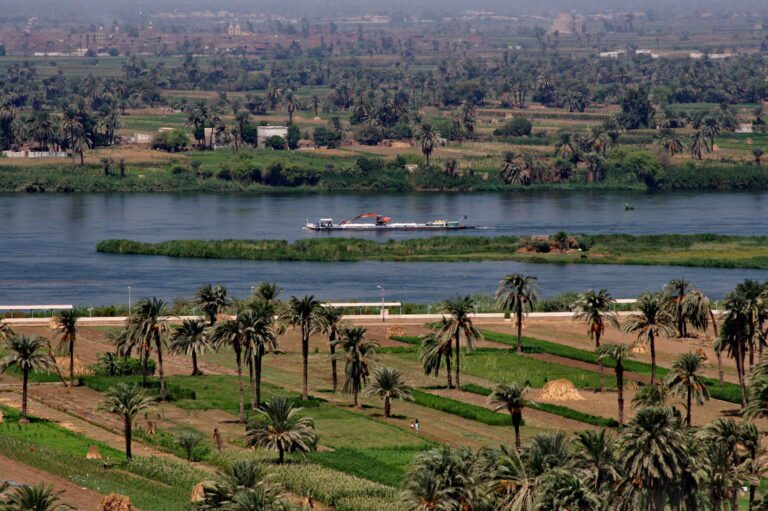
Tel El Amarna was the capital city founded by Akhnaton, He changed the ancient Egyptian multi god belief system, making Aten the spiritual focus. It is believed that Akhnaton may have established this city to locate his capital city away from Thebes (Luxor today) and the old religious order. It was called Akhetaten (ancient Egyptian meaning “Horizon of the Aten”), but subsequently became known as Amarna.
We explore the ancient city and necropolis remains, including the palace where Akhnaton, his wife Nefertiti, and his son Tutankhamun lived, temples and the royal tomb, and the tombs of the nobles.
We then visit El Ashmunein, followed by the necropolis of Tuna El Gabal, the largest Graeco-Roman necropolis in Egypt. It is the necropolis of the ancient city Hermopolis which was a city of creativity, philosophy and enlightenment where the philosophical Hermetica was written. The area includes homes, temples, and tombs. Most structures are dated from 300 BC to 300 AD. One of the best known tombs is that of Petosiris, a priest of the god Thoth. In the catacombs of the necropolis were found tens of thousands of mummified ibis birds and also baboons, both sacred to Thoth. The Boundary Stelae of Akhenaten, rock inscriptions in the surrounding cliffs that are among the oldest recorded statements of the foundation of a city. We move on to Beni Hasan, a unique site because in the upper cemetery the images and inscriptions on the walls of some of the tombs still have their original colors and details, showing traditional scenes of daily life. Dating from the 6th to 12th Dynasties (the late Old Kingdom, First Intermediate Period and into the Middle Kingdom). The number of tombs accessible to the public varies, usually there are four. The view of the area is excellent. A highlight is the current cemetery which features a specific dome architecture.
Dinner and overnight onboard.
Day 4
You have the entire day to enjoy the Nile and relax while sailing to Assiut. Breakfast, lunch, dinner, and overnight on the dahabiya.

Day 5
Early in the morning after breakfast we visit Al Muharraq Monastery then return to dahabiya. Continue sailing to Sohag, lunch, dinner and overnight on board dahabiya.

Dayr al-Muharraq Monastery, the Monastery of the Holy Virgin of al–Muharraq, is surrounded by a wall modeled after the wall of Jerusalem. For Egypt’s Coptic Christians, a pilgrimage to this monastery is equal to a pilgrimage to Jerusalem. Tradition relates that the Holy Family stayed here for six months and five days, and that this is where Jesus returned after his resurrection. This was the point furthest south in their journey and their longest stay in one place in Egypt.
Dayr al-Muharraq also has a century-old episcopal palace and a keep dating from the 6th century.
Another two monasteries await you tomorrow at our next destination, Sohag. On the way, enjoy lunch, dinner and overnight on board.
Day 6
After breakfast visit the White Monastery of Saint Shenouda the Archimandrite, and the Red monastery. Explore Abydos city and Temple. Lunch, dinner and overnight on the dahabiya.

This morning we visit two Coptic monasteries. The name of the White Monastery of Saint Shenouda the Archimandrite refers to the white limestone of its outside walls. Shenouta lived in the 5th century AD and was the abbot of the monastery. It was renovated to the old plan and columns and capitals were reused. Excavations of the monastic settlement surrounding the church are in progress.
The Red Monastery dates to the 5th century AD and still functions as a church; it is considered to be one of the most important monasteries established during the early history of Christianity. The monastery was founded by Saint Bishoy at the beginning of the 4th century AD.
Explore Abydos city and Temple. Abydos is about 10km (6 miles) from the Nile. It is one of the most important archaeological sites of ancient Egypt. Abydos was seen as the gateway to the afterlife for ancient Egyptians. From prehistory graves were situated here, and tombs of the early dynasties were built here even though Abydos was not the seat of power, as it became a pilgrimage center for worship of the god Osiris. The most significant among the monuments in Abydos are those of Seti I and his son Ramses II. Abydos reached the height of its glory under these two kings. Other highlights of Abydos include the Osirion, Ramses II temple, the tombs of the early dynastic kings, and the tomb of Umm Seti.
Abydos continues to be a cult center and pilgrimage destination for many visitors from around the world.
Lunch, dinner and overnight on the dahabiya.
Day 7
Sailing day to Nagaa Hamadi in Qena. Time to relax, read or just take in the beauties of the Nile and watch life on the river and its banks. Breakfast, lunch, dinner and overnight on the dahabiya.
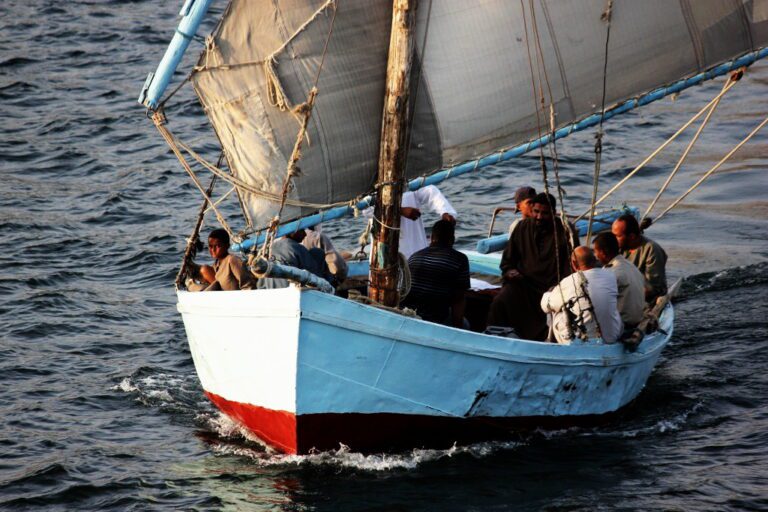
Day 8
After breakfast, visit the complex of Dendera Temple. Sailing to Luxor. Lunch, dinner and overnight on board the dahabiya.

The Temple of Hathor at Dendera has recently undergone restoration to reveal clearly the beauty and color of the art. The ceiling decoration is one of the best preserved of the surviving ancient Egyptian monuments, showing how vibrant colors were used. The Temple of Hathor dates to the first century BC and was continually developed through the Ptolemaic and Roman eras, and refers to both Egyptian rulers and Roman emperors. The site also includes birth houses, a chapel dedicated to Isis, the gateways of Domitian and Trajan, and a Coptic Christian basilica circa 5th century AD. On the temple exterior is a carving of Cleopatra VII Philopator (the most widely known of the rulers called Cleopatra) and her son, whose father was Julius Caesar.
Day 9
After breakfast, visit Luxor’s West Bank including the Valley of the Kings, the temple of Queen Hatshepsut and the Colossi of Memnon. Lunch. Late afternoon to evening visit Luxor Temple and the Avenue of Sphinxes.
Dinner and overnight overnight onboard the dahabiya.
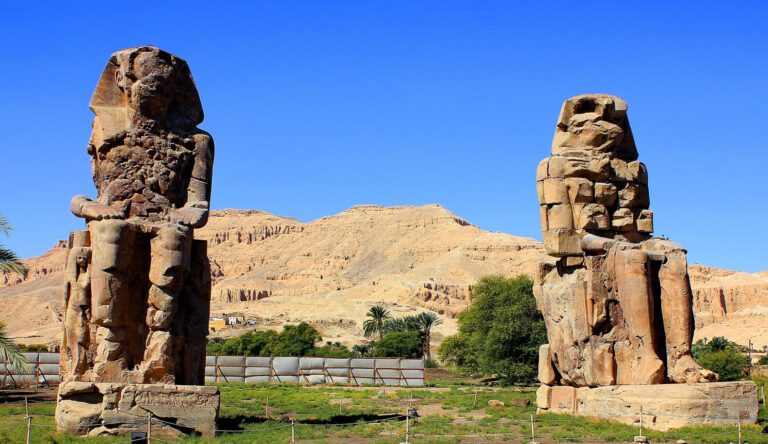
On the West bank our first stop is to see the Colossi of Memnon. These two imposing sandstone statues indicate the site of the mortuary temple of 18th dynasty pharaoh Amenhotep III
(1386 – 1353 BC). 18 meters (59 feet) high and each is estimated to weigh 653 tonnes (720 tons). Visit the Valley of the Kings where your tour guide will lead you to the most important tombs among the currently open tombs in the valley. You visit 3 tombs of the more than 10 tombs that are currently open. Visit Hatshepsut temple. Lunch.
Late afternoon to evening: visit Luxor Temple and the Avenue of Sphinxes. On the East bank of Luxor, bookending the modern city, are the ancient Theban temples of Karnak and Luxor, with the Avenue of Sphinxes and Luxor Museum between them. Luxor Temple is located approximately three kilometers (1.86 miles) south of Karnak Temple. These temples were linked with a processional way bordered with sphinxes, now known as Avenue of the Sphinxes. It is the only temple in the world where ancient Egyptian religions, Greek and Roman cults, Christianity and Islam have been practiced. The temple was substantially built by Amenhotep III (c.1390–1352 BC) and Ramesses II (1279–1213 BC).
Dinner and overnight overnight onboard the dahabiya.
Day 10
After breakfast explore the East Bank including Karnak Temple. Sail to Esna. Lunch, dinner and overnight onboard the dahabiya.

Karnak Temple is huge, the site covers more than 100 hectares (247 acres). Construction at Karnak began during the reign of Senusret I in the Middle Kingdom (2000 – 1700 BC) and continued into the Ptolemaic era (305–30 BC). Most other temples in Egypt were not constructed and used over such a long time and with many rulers involved in construction here.
Sail to Esna, with lunch, dinner and overnight onboard the dahabiya.
Day 11
Esna. Visit Esna Temple, Wekalet Al-Geddawi, a caravanserai, and the Ottoman era market of Al-Qaisariya. Sail through the lock and towards Edfu. Visit El Hegz village. Lunch and dinner on the dahabiya.

In Esna we explore the Temple dedicated to the ram headed god Khnum. The temple sits below street level within the town, as it was excavated from layers of earth. Enjoy discovering heritage craft traditions including beautiful textiles as we visit the restored Wekalet Al-Geddawi, a caravanserai, and the Ottoman era market of Al-Qissariya.
Returning to the dahabiya, we sail to El Hegz Village. This is an opportunity for true cross cultural exchange as we visit a local family who are excited to have visitors from the wider world. Your guide will translate so you can ask them questions and enhance your understanding of village culture.
Lunch, dinner and overnight on the dahabiya.
Day 12
Breakfast on board, sailing to El Kab. From the village we walk (or you can go by donkey, motorized tricycle, or tuk tuk) to see the massive walls of the ancient town of Nekheb and explore the New Kingdom tombs. Sail to Edfu, horse drawn carriages to visit the Temple of Horus. Sailing with dinner and free time as you overnight on the dahabiya.
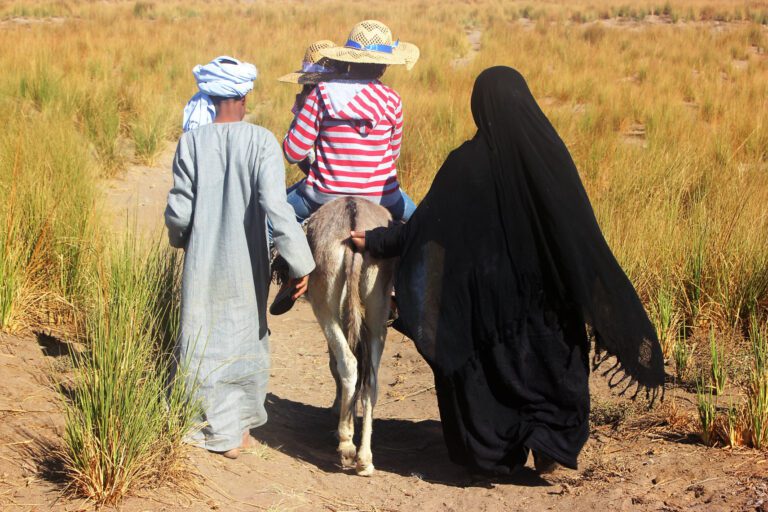
At El Kab remains of ancient settlements date from about 3,000 BC (possibly centuries earlier) to Roman rule. The site is one of the most unique in Egypt because ancient villages and cities are rarely found. As we move inland you will see remains of the impressive mud brick walls and the long valley lined with tombs and shrines, including temples dedicated to Nekhbet and Thoth. We enter the decorated tombs of New Kingdom officials from the area.
We board the dahabiya for lunch and sail to Edfu. Horse drawn carriages take us to the imposing Temple with its grand spaces and many hieroglyphic inscriptions. If time allows we also stroll through the local market.
We sail again, time to relax with dinner, and drift into dreams as you are now becoming part of the rhythms of the Nile.
Day 13
Bisaw Island and village, breakfast in a local home. Walk through farms and meet the villagers. join the men in their boats to share the experience of Nile fishing. Sailing to El Selsela ancient sandstone quarry and shrines. Lunch and dinner both on board.
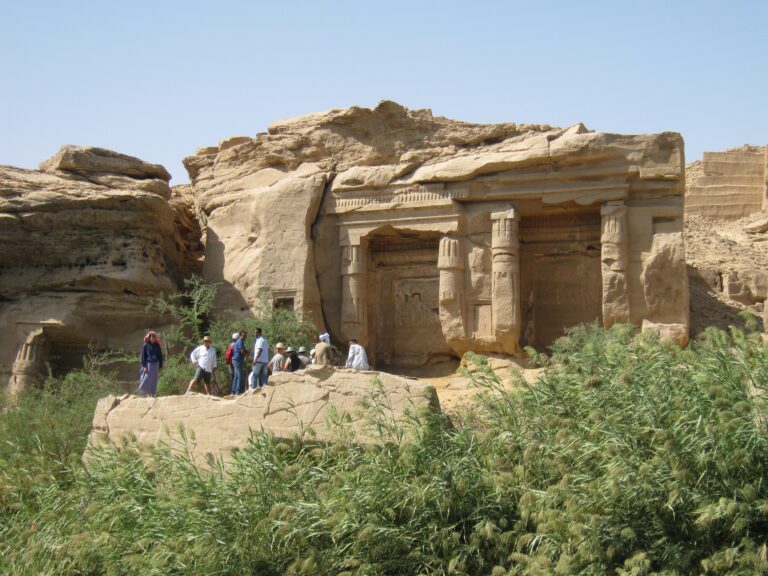
Breakfast in a local home in Bisaw village, where we take a leisurely walk through a farm, meet some of the women and children and learn how the unique sun bread is baked in homes here. We are welcomed by the local fishermen to their boats, learning of the skills of these men who live in harmony with the Nile. Fish caught can be enjoyed as part of dinner on board that evening.
Lunch as we sail to El Sesela where we take a short walk parallel to the Nile to visit shrines and a massive quarry. Large amounts of sandstone was quarried here for temple building in Thebes (Luxor). Cut into the rock are the speos (chapel) of Horemheb with its sanctuary containing rock shrines and various stelae and inscriptions. The huge quarry gives context to how much building material was sourced from this area. There is also an area of sand here where children (and children at heart) can slide and play.
We sail towards Kom Ombo, dinner and another tranquil night on board.
Day 14
Breakfast on board. Visit Kom Ombo temple and the Crocodile Museum. In the nearby Daraw Nubian town you learn how to shop like a local at the market, visit a barn to meet camels and learn about the camel trade, and as we sail closer to Aswan if you wish there is an opportunity to swim or kayak. Farewell dinner and sail to our final destination Aswan.

A short walk from the dahabiya dock, the Temple of Kom Ombo is dedicated to the crocodile-featured god Sobek and the god Horus. The connection to the power of the Nile is unmistakable as you look towards the temple. We also visit the Crocodile Museum which includes some impressive mummified crocodiles.
In nearby Daraw explore a town that will give you a different sense of Egyptian life than what you see in the big cities. Daraw includes several Nubian communities hyperlink to text of Nubian Villages in Attractions. We will stop at a cafe to try a local drink such as halfabar. We can plan our dinner for that night and learn how to shop, including a few words of Arabic, then try your new skills in the market shopping for ingredients for dinner. This is a fun opportunity to interact with the market traders. Ask your guide about shopping for other items too, including Arabic words and prices. You will visit a barn for an introduction to camels, giving you some interaction with camels and to learn about these fascinating animals and about the camel trade. Note: if your tour visits Daraw on Saturday or Sunday we visit the camel market instead of the camel barn. On Tuesdays we can visit a livestock market.
As we near Aswan you have the opportunity to swim or kayak. If you wish to kayak please advise us two days before the dahabiya tour begins so we can be sure to have kayaks available.
We set sail on the final stretch of the dahabiya cruise, with lunch and time to reflect on your dahabiya experience. By the farewell dinner we are sure you will be wanting to return to see more of Egypt, and wishing this was not your last night on board the dahabiya.
Day 15
After breakfast check out of the dahabiya and begin your tour of Aswan. Visit the Unfinished Obelisk. Visit the High Dam where we have great views to the Nubian Lake (Lake Nasser) and the Nile River below. Visit the temple of Philae.

Farewell the dahabiya crew, and set out to explore Aswan. Visit the Unfinished Obelisk. Obelisks are four-sided, tapered monuments which were called tekhenu by the Ancient Egyptians. It is estimated that the unfinished obelisk would have measured 42 meters (138 feet) and weighed 1,089 tonnes (1,200 tons), which would have made it the largest obelisk constructed by the ancient Egyptians.
After lunch we visit the High Dam and enjoy views of the Old Aswan Dam and the Nubian Lake (Lake Nasser). Seeing the High Dam and lake adds to your understanding of how the changing flow of the Nile has influenced Egyptian history. The dam was built to control the flooding of the Nile, increase water storage for irrigation, and generate hydroelectricity. It was a controversial plan because the dam would flood the lands of the Nubian people and cover remains of previous societies including several important ancient Egyptian temples. However, the large area flooded caused the relocation of more than 100,000 people. Many archaeological sites were submerged.
We take a boat to visit Philae, giving you a picturesque approach to the site. During the 1960s the monuments on this island were relocated from the original Philae island nearby so they would not be flooded because of the construction of the Aswan High Dam. Philae includes many structures, mostly dating to the Ptolemaic era (332–30 BC). The most prominent of these is a temple dedicated to Isis, begun by Ptolemy II Philadelphus. This temple was one of the last ancient Egyptian temples to remain active, until Emperor Justinian I (527–565 AD). The temple was converted into a Christian church.
| Dahabiya Tour Detailed Quote |
|---|
| USD 705 Per Person in Double Cabin |
|
| USD 250 Per Suite Per 3 Nights |
|
| USD 540 Per Person Per Cabin |
|
| NOT INCLUDING |
|
| NOTES |
|
© Dahabiya Nile Sailing Egypt 2024